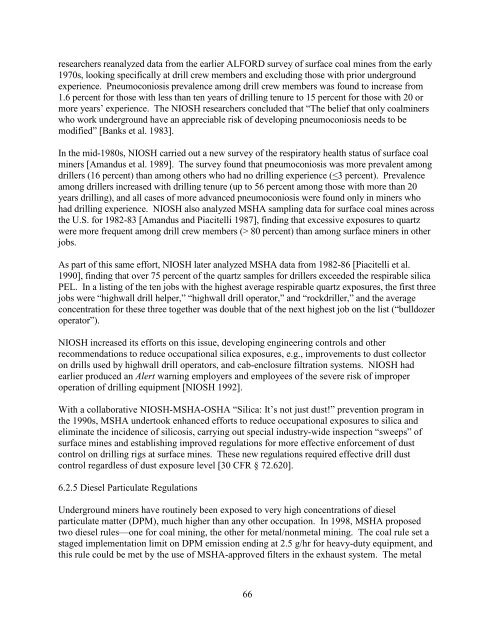One Hundred Years of Federal Mining Safety and Health Research
One Hundred Years of Federal Mining Safety and Health Research
One Hundred Years of Federal Mining Safety and Health Research
- No tags were found...
You also want an ePaper? Increase the reach of your titles
YUMPU automatically turns print PDFs into web optimized ePapers that Google loves.
esearchers reanalyzed data from the earlier ALFORD survey <strong>of</strong> surface coal mines from the early<br />
1970s, looking specifically at drill crew members <strong>and</strong> excluding those with prior underground<br />
experience. Pneumoconiosis prevalence among drill crew members was found to increase from<br />
1.6 percent for those with less than ten years <strong>of</strong> drilling tenure to 15 percent for those with 20 or<br />
more years’ experience. The NIOSH researchers concluded that “The belief that only coalminers<br />
who work underground have an appreciable risk <strong>of</strong> developing pneumoconiosis needs to be<br />
modified” [Banks et al. 1983].<br />
In the mid-1980s, NIOSH carried out a new survey <strong>of</strong> the respiratory health status <strong>of</strong> surface coal<br />
miners [Am<strong>and</strong>us et al. 1989]. The survey found that pneumoconiosis was more prevalent among<br />
drillers (16 percent) than among others who had no drilling experience ( 80 percent) than among surface miners in other<br />
jobs.<br />
As part <strong>of</strong> this same effort, NIOSH later analyzed MSHA data from 1982-86 [Piacitelli et al.<br />
1990], finding that over 75 percent <strong>of</strong> the quartz samples for drillers exceeded the respirable silica<br />
PEL. In a listing <strong>of</strong> the ten jobs with the highest average respirable quartz exposures, the first three<br />
jobs were “highwall drill helper,” “highwall drill operator,” <strong>and</strong> “rockdriller,” <strong>and</strong> the average<br />
concentration for these three together was double that <strong>of</strong> the next highest job on the list (“bulldozer<br />
operator”).<br />
NIOSH increased its efforts on this issue, developing engineering controls <strong>and</strong> other<br />
recommendations to reduce occupational silica exposures, e.g., improvements to dust collector<br />
on drills used by highwall drill operators, <strong>and</strong> cab-enclosure filtration systems. NIOSH had<br />
earlier produced an Alert warning employers <strong>and</strong> employees <strong>of</strong> the severe risk <strong>of</strong> improper<br />
operation <strong>of</strong> drilling equipment [NIOSH 1992].<br />
With a collaborative NIOSH-MSHA-OSHA “Silica: It’s not just dust!” prevention program in<br />
the 1990s, MSHA undertook enhanced efforts to reduce occupational exposures to silica <strong>and</strong><br />
eliminate the incidence <strong>of</strong> silicosis, carrying out special industry-wide inspection “sweeps” <strong>of</strong><br />
surface mines <strong>and</strong> establishing improved regulations for more effective enforcement <strong>of</strong> dust<br />
control on drilling rigs at surface mines. These new regulations required effective drill dust<br />
control regardless <strong>of</strong> dust exposure level [30 CFR § 72.620].<br />
6.2.5 Diesel Particulate Regulations<br />
Underground miners have routinely been exposed to very high concentrations <strong>of</strong> diesel<br />
particulate matter (DPM), much higher than any other occupation. In 1998, MSHA proposed<br />
two diesel rules—one for coal mining, the other for metal/nonmetal mining. The coal rule set a<br />
staged implementation limit on DPM emission ending at 2.5 g/hr for heavy-duty equipment, <strong>and</strong><br />
this rule could be met by the use <strong>of</strong> MSHA-approved filters in the exhaust system. The metal<br />
66
















